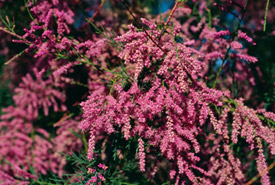
Salt-cedar flowers (Photo by Steve Dewey, Utah State University)
Salt-cedar
Salt-cedar (commonly known as “pink cascade” and tamarisk) has been identified as an invasive alien species by the Canadian Food Inspection Agency, named as one of The Nature Conservancy’s (U.S.) "dirty dozen" weeds and listed as one of the World Conservation Union’s 100 "worst invaders."
How is it identified?
- Its tall deciduous shrubs or small trees grow four and a half metres (15 feet) in height.
- Its flowers are small pink to white dense masses on long spikes at the end of twigs.
- The bark of young branches is smooth and reddish-brown, becoming furrowed and purplish-brown with age.
- Leaves are scale-like, bluish-green, very small and overlap each other along the stem.
How does it grow?
Salt-cedar has great reproductive capability. Its seeds are easily dispersed by wind and water, and severed stems root in moist soil.
Where does it grow?
An ornamental shrub native to Asia and Africa, salt-cedar has escaped from the garden into the wild. Although it is not naturalized in Canada, it is present in almost all American states, including North Dakota and Montana. Salt-cedar has adapted to tolerate a wide variety of environmental conditions and mainly occurs along disturbed streambanks, lakeshores, irrigation ditches and wetlands.
Salt-cedar is currently not on the Manitoba Noxious Weeds List and as a result can be purchased at nurseries and garden centres throughout Manitoba.
What does it threaten?
Salt-cedar has the potential to cause serious and irreversible damage to Canada's native ecosystems, economy and society. This invasive alien species is an aggressive plant that requires a massive amount of water to survive. It forms dense thickets that crowds out desirable native plant species, creates deposits of salt, reduces water tables, drains wetlands and clogs waterways with its extensive root system.
What is NCC doing to this species?
Invasive alien species such as salt-cedar threaten the ecological health of the Nature Conservancy of Canada's (NCC's) conservation lands. They do not respect jurisdictional borders and will establish themselves, regardless of property ownership.
In Manitoba, NCC is working in collaboration with the Invasive Species Council of Manitoba — a province-wide leadership body that has adopted a cooperative approach involving a number of key organizations and agencies to eradicate or limit further spread of invasive species.
An integrated approach involving awareness, prevention, early detection and rapid response are likely our best defence at controlling the entry of new invaders from becoming widespread infestations.
How can you help?
Everyone can help to win the battle against alien invasive species. Here are some ways you can help:
- Dispose of yard waste properly. Dumping yard waste in natural areas can introduce alien invasive species that will thrive and spread. Even leaf piles can be problematic, as dumped piles can smother native vegetation. Contact your municipality to find out how to dispose of yard waste properly.
- Plant native species in your garden. There are lots of beautiful native species that attract native butterflies and birds, making your garden twice as beautiful. Native species are also adapted to our climate and often require less rigorous care than exotic species.
- Report sightings of invasive plants to your local stewardship council. Finding these invasions early is key to eradicating them.
- Clean your shoes or bicycle tires when moving between designated trails in different areas. Invasive plants are often spread accidentally from seeds stuck in treads.




